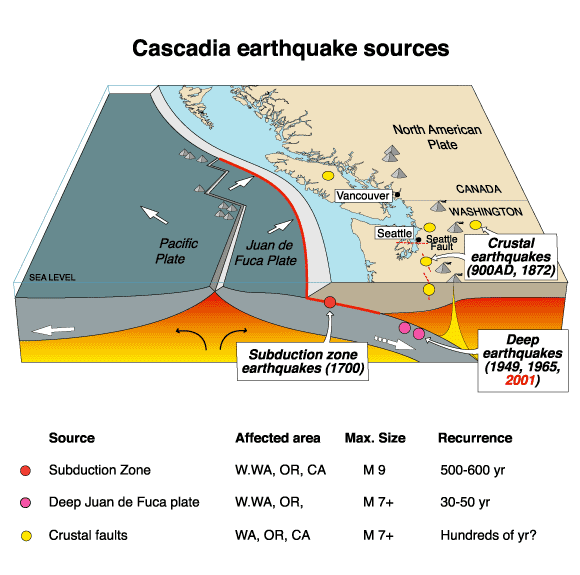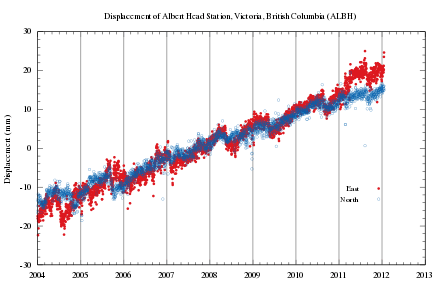Episodic tremor and slip
Episodic tremor and slip (ETS) is a seismological phenomenon observed in some subduction zones that is characterized by non-earthquake seismic rumbling, or tremor, and slow slip along the plate interface. Slow slip events are distinguished from earthquakes by their propagation speed and focus. In slow slip events, there is an apparent reversal of crustal motion, although the fault motion remains consistent with the direction of subduction. ETS events themselves are imperceptible to human beings and do not cause damage.[1]
Discovery

Nonvolcanic, episodic tremor was first identified in southwest Japan in 2002.[2] Shortly after, the Geological Survey of Canada coined the term "episodic tremor and slip" to characterize observations of GPS measurements in the Vancouver Island area.[3] Vancouver Island lies in the eastern, North American region of the Cascadia subduction zone. ETS events in Cascadia were observed to reoccur cyclically with a period of approximately 14 months.[4] Analysis of measurements led to the successful prediction of ETS events in following years (e.g., 2003, 2004, 2005, and 2007). In Cascadia, these events are marked by about two weeks of 1 to 10 Hz seismic trembling and non-earthquake ("aseismic") slip on the plate boundary equivalent to a magnitude 7 earthquake. (Tremor is a weak seismological signal only detectable by very sensitive seismometers.) Recent episodes of tremor and slip in the Cascadia region have occurred down-dip of the region ruptured in the 1700 Cascadia earthquake.
Since the initial discovery of this seismic mode in the Cascadia region, slow slip and tremor have been detected in other subduction zones around the world, including Japan and Mexico.[5] Slow slip is not accompanied by tremor in the Hikurangi Subduction Zone.[6]
Every five years a year-long quake of this type occurs beneath the New Zealand capital, Wellington. It was first measured in 2003, and has reappeared in 2008 and 2013.[7]
Characteristics
Slip behaviour

In the Cascadia subduction zone, the Juan de Fuca Plate, a relic of the ancient Farallon Plate, is actively subducting eastward underneath the North American Plate. The boundary between the Juan de Fuca and North American plates is generally "locked" due to interplate friction. A GPS marker on the surface of the North American plate above the locked region will trend eastward as it is dragged by the subduction process. Geodetic measurements show periodic reversals in the motion (i.e., westward movement) of the overthrusting North American Plate.[4] During these reversals, the GPS marker will be displaced to the west over a period of days to weeks. Because these events occur over a much longer duration than earthquakes, they are termed "slow slip events".
Slow slip events have been observed to occur in the Cascadia, Japan, and Mexico subduction zones.[5] Unique characteristics of slow slip events include periodicity on timescales of months to years, focus near or down-dip of the locked zone, and along-strike propagation of 5 to 15 km/d.[5] In contrast, a typical earthquake rupture velocity is 70 to 90% of the S-wave velocity, or approximately 3.5 km/s.
Because slow slip events occur in subduction zones, their relationship to megathrust earthquakes is of economic, human, and scientific importance. The seismic hazard posed by ETS events is dependent on their focus. If the slow slip event extends into the seismogenic zone, accumulated stress would be released, decreasing the risk of a catastrophic earthquake.[8][9] However, if the slow slip event occurs down-dip of the seismogenic zone, it may "load" the region with stress.[8][10] The probability of a great earthquake (moment magnitude scale ) occurring has been suggested to be 30 times greater during an ETS event than otherwise,[11] but more recent observations have shown this theory to be simplistic.[12] One factor is that tremor occurs in many segments at different times along the plate boundary; another factor is that rarely have tremor and large earthquakes been observed to correlate in timing .[13]
Tremor
Slow slip events are frequently linked to non-volcanic seismological "rumbling", or tremor. Tremor is distinguished from earthquakes in several key respects: frequency, duration, and origin. Seismic waves generated by earthquakes are high-frequency and short-lived. These characteristics allow seismologists to determine the hypocentre of an earthquake using first-arrival methods. In contrast, tremor signals are weak and extended in duration.[14] Furthermore, while earthquakes are caused by the rupture of faults, tremor is generally attributed to underground movement of fluids (magmatic or hydrothermal).[15] As well as in subduction zones, tremor has been detected in transform faults such as the San Andreas.[16]
In both the Cascadia and Nankai subduction zones, slow slip events are directly associated with tremor.[4][17] In the Cascadia subduction zone, slip events and seismological tremor signals are spatially and temporally coincident,[18] but this relationship does not extend to the Mexican subduction zone.[19] Furthermore, this association is not an intrinsic characteristic of slow slip events. In the Hikurangi Subduction Zone, New Zealand, episodic slip events are associated with distinct, reverse-faulted microearthquakes.[6]
Two types of tremor have been identified: one associated with geodetic deformation (as described above), and one associated with 5 to 10 second bursts excited by distant earthquakes. The second type of tremor has been detected worldwide; for example, it has been triggered in the San Andreas Fault by the 2002 Denali earthquake and in Taiwan by the 2001 Kunlun earthquake.[20][21]
Geological interpretation
Tremor is commonly associated with the underground movement of magmatic or hydrothermal fluids.[15] As a plate is subducted into the mantle, it loses water from its porespace and due to phase changes of hydrous minerals (such as amphibole). It has been proposed that this liberation of water generates a supercritical fluid at the plate interface, lubricating plate motion.[22] This supercritical fluid may open fractures in the surrounding rock, and that tremor is the seismological signal of this process.[22] Mathematical modelling has successfully reproduced the periodicity of episodic tremor and slip in the Cascadia region by incorporating this dehydration effect.[23] In this interpretation, tremor may be enhanced where the subducting oceanic crust is young, hot, and wet as opposed to older and colder.
However, alternative models have also been proposed. Tremor has been demonstrated to be influenced by tides or variable fluid flow through a fixed volume.[8][24] Tremor has also been attributed to shear slip at the plate interface.[4] Recent contributions in mathematical modelling reproduce the sequences of Cascadia and Hikurangi (New Zealand), and suggest in-situ dehydration as the cause for the episodic tremor and slip events.[25][26][27]
References
- "Episodic Tremor and Slip beneath Vancouver Island". Natural Resources Canada. Archived from the original on 26 March 2010. Retrieved 17 June 2011.
- Obara, Kazushige (2002). "Nonvolcanic Deep Tremor Associated with Subduction in Southwest Japan". Science. 296 (5573): 1679–1681. Bibcode:2002Sci...296.1679O. doi:10.1126/science.1070378. PMID 12040191. S2CID 32354691.
- "Geodynamics – Episodic Tremor and Slip (ETS)". Natural Resources Canada – Geological Survey of Canada. Archived from the original on 4 June 2011. Retrieved 17 June 2011.
- Rogers, G.; Dragert, H. (2003). "Episodic Tremor and Slip on the Cascadia Subduction Zone: The Chatter of Silent Slip". Science. 300 (5627): 1942–1943. Bibcode:2003Sci...300.1942R. doi:10.1126/science.1084783. PMID 12738870.
- Liu, Yajing; Rice, James R. (2009). "Slow slip predictions based on granite and gabbro friction data compared to GPS measurements in northern Cascadia". Journal of Geophysical Research. 114 (B9): B09407. Bibcode:2009JGRB..114.9407L. doi:10.1029/2008JB006142.
- Delahaye, E.J.; Townend, J.; Reyners, M.E.; Rogers, G. (2009). "Microseismicity but no tremor accompanying slow slip in the Hikurangi subduction zone, New Zealand". Earth and Planetary Science Letters. 277 (1–2): 21–28. Bibcode:2009E&PSL.277...21D. doi:10.1016/j.epsl.2008.09.038.
- "'Silent' quake gently rocks Wellington". 3 News NZ. May 28, 2013. Archived from the original on August 23, 2014. Retrieved May 28, 2013.
- Rubinstein, J., Shelly, D., Ellsworth, W. (2010), "Non-volcanic Tremor: A Window into the Roots of Fault Zones", in New Frontiers in Integrated Solid Earth Sciences, edited by S. Cloetingh and J. Negendank, pp. 287–314, Springer Science+Business Media B.V., doi:10.1007/978-90-481-2737-5_8
- Kostoglodov, V.; Singh, S.; Santiago, J.; Franco, S.; Larson, K.; Lowry, A.; Bilham, R. (2003). "A large silent earthquake in the Guerrero seismic gap, Mexico". Geophysical Research Letters. 30 (15): 1807. Bibcode:2003GeoRL..30.1807K. doi:10.1029/2003GL017219.
- Brudzinski, M.; Cabral-Cano, E.; Correa-Mora, F.; Demets, C.; Márquez-Azúa, B. (2007). "Slow slip transients along the Oaxaca subduction segment from 1993 to 2007". Geophysical Journal International. 171 (2): 523–538. Bibcode:2007GeoJI.171..523B. doi:10.1111/j.1365-246X.2007.03542.x.
- Mazzotti, S. (2004). "Variability of Near-Term Probability for the Next Great Earthquake on the Cascadia Subduction Zone". Bulletin of the Seismological Society of America. 94 (5): 1954–1959. Bibcode:2004BuSSA..94.1954M. doi:10.1785/012004032.
- Beroza, G. C.; Ide, S. (2011). "Non-Volcanic Tremor and Slow Earthquakes". Annu. Rev. Earth Planet. Sci. 39: 271–296. Bibcode:2011AREPS..39..271B. doi:10.1146/annurev-earth-040809-152531.
- Brudzinski, M.; Allen, R. (2007). "Segmentation in episodic tremor and slip all along Cascadia". Geology. 35 (10): 905–910. Bibcode:2007Geo....35..907B. doi:10.1130/G23740A.1. S2CID 6682060.
- Shelly, David R.; Beroza, Gregory C.; Ide, Satoshi (2007). "Non-volcanic tremor and low-frequency earthquake swarms". Nature. 446 (7133): 305–307. Bibcode:2007Natur.446..305S. doi:10.1038/nature05666. PMID 17361180.
- Schwartz, Susan Y.; Rokosky, Juliana M. (2007). "Slow slip events and seismic tremor at circum-Pacific subduction zones". Reviews of Geophysics. 45 (3): n/a. Bibcode:2007RvGeo..45.3004S. doi:10.1029/2006RG000208. S2CID 128205122.
- Nadeau, R. M.; Dolenc, D. (2005). "Nonvolcanic Tremors Deep Beneath the San Andreas Fault". Science. 307 (5708): 389. doi:10.1126/science.1107142. PMID 15591163. S2CID 32405993.
- Obara, Kazushige; Hirose, Hitoshi; Yamamizu, Fumio; Kasahara, Keiji (2004). "Episodic slow slip events accompanied by non-volcanic tremors in southwest Japan subduction zone". Geophysical Research Letters. 31 (23): L23602. Bibcode:2004GeoRL..3123602O. doi:10.1029/2004GL020848.
- Bartlow, Noel M.; Miyazaki, Shin'Ichi; Bradley, Andrew M.; Segall, Paul (2011). "Space-time correlation of slip and tremor during the 2009 Cascadia slow slip event". Geophysical Research Letters. 38 (18): n/a. Bibcode:2011GeoRL..3818309B. doi:10.1029/2011GL048714.
- Payero, Juan S.; Kostoglodov, Vladimir; Shapiro, Nikolai; Mikumo, Takeshi; Iglesias, Arturo; Pérez-Campos, Xyoli; Clayton, Robert W. (2008). "Nonvolcanic tremor observed in the Mexican subduction zone". Geophysical Research Letters. 35 (7): n/a. Bibcode:2008GeoRL..35.7305P. doi:10.1029/2007GL032877. hdl:2433/193421.
- Peng, Zhigang; Vidale, John E.; Creager, Kenneth C.; Rubinstein, Justin L.; Gomberg, Joan; Bodin, Paul (2008). "Strong tremor near Parkfield, CA, excited by the 2002 Denali Fault earthquake". Geophysical Research Letters. 35 (23): L23305. Bibcode:2008GeoRL..3523305P. doi:10.1029/2008GL036080.
- Peng, Zhigang; Chao, Kevin (2008). "Non-volcanic tremor beneath the Central Range in Taiwan triggered by the 2001 Kunlun earthquake". Geophysical Journal International. 175 (2): 825–829. doi:10.1111/j.1365-246X.2008.03886.x.
- Obara, K. (2002). "Nonvolcanic Deep Tremor Associated with Subduction in Southwest Japan". Science. 296 (5573): 1679–1681. Bibcode:2002Sci...296.1679O. doi:10.1126/science.1070378. PMID 12040191. S2CID 32354691.
- Liu, Yajing; Rice, James R. (2007). "Spontaneous and triggered aseismic deformation transients in a subduction fault model". Journal of Geophysical Research. 112 (B9): B09404. Bibcode:2007JGRB..112.9404L. doi:10.1029/2007JB004930.
- Watanabe, Tomoko; Hiramatsu, Yoshihiro; Obara, Kazushige (2007). "Scaling relationship between the duration and the amplitude of non-volcanic deep low-frequency tremors". Geophysical Research Letters. 34 (7): L07305. Bibcode:2007GeoRL..34.7305W. doi:10.1029/2007GL029391. hdl:2297/6771.
- Alevizos, S.; Poulet, T.; Veveakis, E. (2014). "Thermo-poro-mechanics of chemically active creeping faults. 1: Theory and steady state considerations". Journal of Geophysical Research: Solid Earth. 119 (6): 4558–4582. Bibcode:2014JGRB..119.4558A. doi:10.1002/2013JB010070.
- Veveakis, E.; Poulet, T.; Alevizos, S. (2014). "Thermo-poro-mechanics of chemically active creeping faults: 2. Transient considerations". Journal of Geophysical Research: Solid Earth. 119 (6): 4583–4605. Bibcode:2014JGRB..119.4583V. doi:10.1002/2013JB010071.
- Poulet, T.; Veveakis, E.; Regenauer-Lieb, K.; Yuen, D. A. (2014). "Thermo-poro-mechanics of chemically active creeping faults: 3. The role of serpentinite in episodic tremor and slip sequences, and transition to chaos". Journal of Geophysical Research: Solid Earth. 119 (6): 4606–4625. Bibcode:2014JGRB..119.4606P. doi:10.1002/2014JB011004.